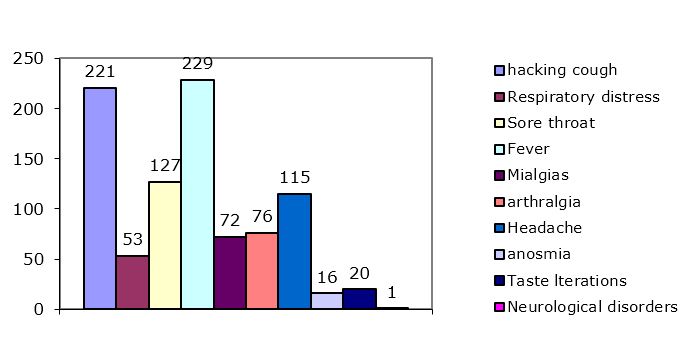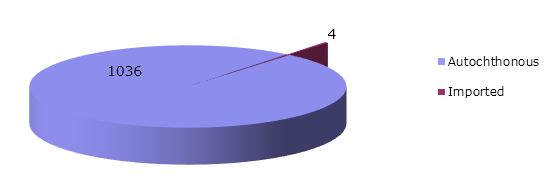Mi SciELO
Servicios Personalizados
Articulo
Indicadores
-
 Citado por SciELO
Citado por SciELO
Links relacionados
-
 Similares en
SciELO
Similares en
SciELO
Compartir
Revista de Ciencias Médicas de Pinar del Río
versión On-line ISSN 1561-3194
Rev Ciencias Médicas vol.26 no.2 Pinar del Río mar.-abr. 2022 Epub 01-Mar-2022
Original Article
Clinical-epidemiological behavior of SARS-COV-2 infection in Minas de Matahambre
1University of Medical Sciences of Pinar del Río. Community Polyclinic Jose Elias Borges. Matahambre mines. Pinar del Río. Cuba.
Introduction:
the World Health Organization on February 12th, 2020 officially named COVID-19 the infectious disease caused by the new SARS-CoV-2 coronavirus.
Objective:
to describe the clinical and epidemiological characteristics of patients confirmed with SARS-CoV-2 in Minas de Matahambre municipalty from March 2020 to July 2021.
Methods:
an observational, descriptive, cross-sectional, descriptive study was conducted on 1040 patients diagnosed with COVID-19 in the municipality from March 2020 to July 31st, 2021 who met the inclusion criteria, the variables studied were: age, sex, race, schooling, marital status, comorbidities, symptoms and origin of infection, the data were obtained from medical records and epidemiological surveys; they were analyzed by descriptive statistics using absolute and relative frequencies.
Results:
autochthonous transmission, male sex (52,1 %), white race (69,1 %), 45 to 59 years of age (27,3 %), high school level and marital status with stable union predominated in the research; fever prevailed (22,1 %) and hypertension was representative among comorbidities (10 %).
Conclusions:
there was a predominance of male sex, 45 to 59 years of age, white race, high school level and marital status of stable union. Personal history of hypertension, ischemic heart disease and diabetes mellitus also predominated; the most frequent symptoms were fever, cough and sore throat.
Key words: CORONAVIRUS; COVID-19; EPIDEMIOLOGY; PRIMARY HEALTH CARE
INTRODUCTION
It is well known that many respiratory infections, ranging from the common cold to severe acute respiratory syndrome are caused by an extensive family of viruses known as coronaviruses.1
The World Health Organization on February 12, 2020 officially named COVID-19 the infectious disease caused by the new SARS-CoV-2 coronavirus. As early as December 2019, the first cases had appeared in the capital of Hubei province in central China; by that date, COVID-19 is considered a pandemic. The first report of a case in Cuba was in March 2020 from Italian tourists.2
According to statistics from the Cuban Ministry of Public Health, as of July 31, 2021, the disease has caused around 198 million 418 thousand 289 confirmed cases and 4 million 230 thousand 522 deaths worldwide, for a case fatality rate of 2,13 %. In the Americas, 78 million 31,835 cases and 2 million 28,759 deaths have been reported, with a lethality rate of 2,60 %. Cuba accumulates 6 million 564 thousand 114 samples taken and 394 thousand 343 confirmed cases, 2 845 deaths and a lethality rate of 0,72 %. The municipality of Minas de Matahambre accumulates 1054 confirmed cases, 14 deaths and a lethality rate of 1,32 %.3
The affectation increases in the most vulnerable people, i.e. those who have associated risk factors such as diabetes mellitus, hypertension, young people and the elderly, making them the group most at risk of the disease progressing to more severe forms.4 Since COVID-19 is a little known disease, it is suggested that the immune system may not defend the organism against the virus, so that control mechanisms and physiological response fail, being responsible for the onset of symptoms such as fever, cough, dyspnea, generalized myalgias and arthralgias, sudden loss of taste and smell, characterized in the most severe cases by the presence of acute respiratory distress syndrome, pneumonia and septic shock responsible for almost 3 % of deaths.5,6
The advance of the pandemic has caused crises affecting the economic, political and social sectors of the countries, which have the responsibility to save lives and minimize its impact, so that in the option of developing vaccines in a short time several technologies have been developed, including those of messenger RNA, viral vectors and inactivated viruses.7 Cuban vaccine candidates use the same antigen (RBD) but with two different platforms with a wide development and application in the country.8
COVID-19 has had a great impact at the primary health care level, the municipality of Minas de Matahambre has also suffered the effects of this health problem, encouraging studies related to the disease specifically at the community level, so the present research is aimed at describing the clinical and epidemiological characteristics of patients confirmed with SARS-CoV-2 in Minas de Matahambre municipality from March 2020 to July 2021.
METHODS
An observational, descriptive, cross-sectional, descriptive study was conducted with data recorded in the municipal departments of hygiene, epidemiology and statistics, for all patients diagnosed with COVID-19 in the period from March 2020 to July 2021 residing in Minas de Matahambre municipality. From a target group of 1054 positive cases of COVID-19, the sample consisted of 1040 patients recovered, with epidemiological discharge (real-time polymerase chain reaction [RT-PCR] negative for SARS-CoV-2) 14 days after clinical discharge, who agreed to participate in the study. Exclusion criteria were those who had died and those who were outside the municipality at the time of its diagnosis.
For the collection of information, the data to be studied were obtained from individual clinical histories and epidemiological surveys, and the following variables were evaluated:
General data: health area, age, sex, skin color, schooling, marital status and autochthonous or imported origin of infection, personal pathological history and symptoms and signs.
Confirmed patients were classified into two groups depending on their clinical evolution: Asymptomatic: no clinical symptoms or signs were present during SARS-CoV-2 infection and symptomatic: symptoms and signs of infection were detected, with or without clinical complications during evolution.
The principles of medical ethics and the aspects established in the Declaration of Helsinki were met.
RESULTS
The age group 45 to 59 years (27,3 %) and male sex (52,1 %) predominated. The health area of Jose Elias Borges Polyclinic (Minas) accounted for 27,4 % of the cases (Table 1).
Table 1 Distribution by age group and sex of confirmed cases of COVID-19 according to health areas in Minas de Matahambre, Pinar del Río, 2020-2021
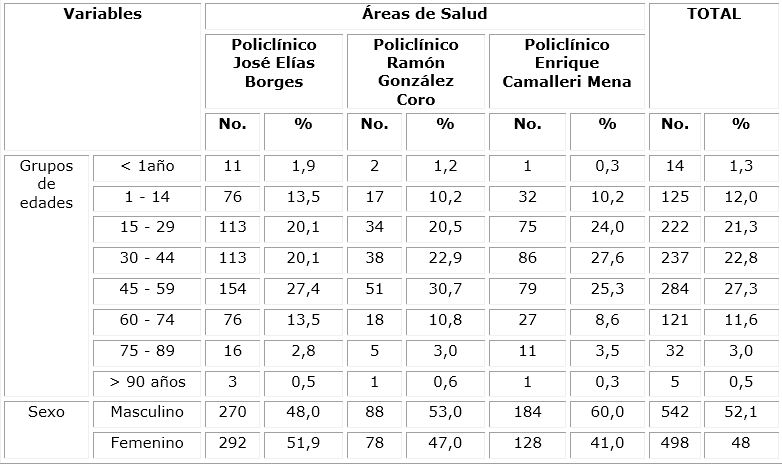
Source: Individual medical records.
There was a predominance of white race (69,7 %), medium-high school level (45,6 %), and stable or consensual union (36,6 %) (Table 2)
Table 2 Behavior of race, schooling and marital status of confirmed cases of COVID-19 according to health areas
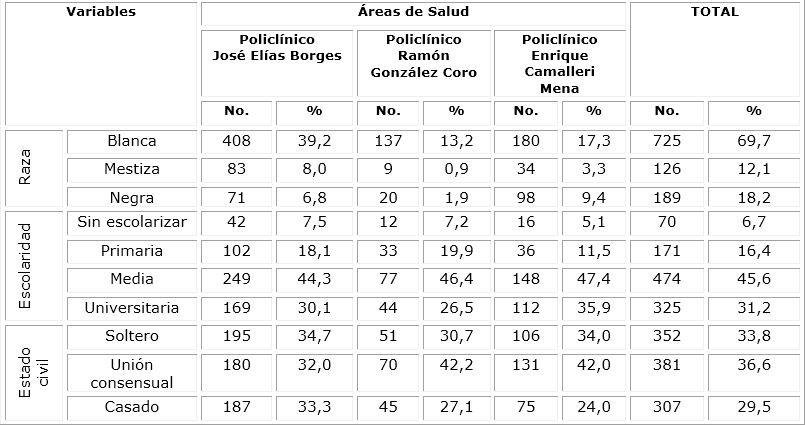
Source: Individual medical records.
Hypertension (10 %) predominated, followed by ischemic heart disease (3,7 %) and diabetes mellitus (2,8 %) (Table 3)
Table 3 Personal pathological history present according to healthcare areas.
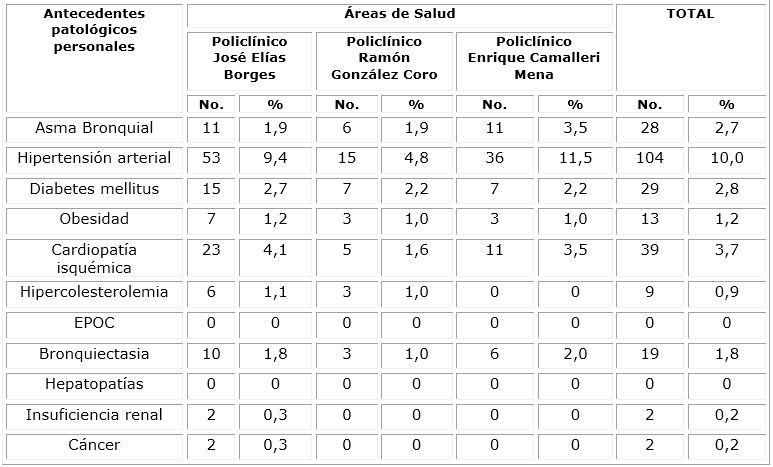
Source: Individual medical records.
Among covid-19 symptoms, fever (22,1 %), cough (21,2 %), sore throat (12,2 %), headache (11 %) and arthralgias (7,3 %) predominated. (Fig. 1)
Autochthonous transmission was predominant in the municipality (98.4%) (Fig. 2)
DISCUSSION
During the period covered by the study, SARC-CoV-2 virus infection predominated in males between 45 and 59 years of age, being representative in the healthcare area of Jose Elias Borges polyclinic (Minas), this area belongs to the municipal capital and therefore it is considered urban area with a larger population, among the hygienic-sanitary measures to be followed by the population there is the limitation of movement, mainly in older adults, since they constitute an important risk group, while younger adults are responsible for meeting the needs of the household therefore they circulate more frequently and generally in this age group decreases the perception of risk by failing to comply with social isolation and therefore are at risk of infection.
Recent studies agree that 50-60 % of middle-aged men are affected by the disease. 7, also in Havana, where the average age was 45 years, equally distributed according to sex.9 In the municipality of Guanabacoa it behaved in a similar way, with a predominance of the 41 to 60 years age group.10 On the other hand, a study carried out in Spain indicates that the proportion of men and women is similar (47,4 % vs. 52,6 %).11 On this aspect, genetic and hormonal causes are suggested to explain the differences in susceptibility according to sex, where some reports justify the lower female susceptibility to contagion due to the protection of the extra X-chromosome of women in relation to men.5
Regarding race, in this study the white race predominated in general in the confirmed cases of Covid-19, individually from the demographic point of view, the health area of Santa Lucia is representative of the black race, however, in the healthcare areas of Minas and Sumidero the white race predominates.
In his review article on the behavior of the disease in different countries, Santos Ferreira points out that 92,8 % agree that black people have a greater vulnerability to disease. From the genetic point of view, some authors suggest that the increased vulnerability of the black race is due to the possibility of genetic polymorphism and the response of these people to drugs,12 the results are still incipient, but they do agree that vulnerability is multi-causal and they state as reasons that in many countries black people generally present economic difficulties that bring with them greater difficulty for diagnosis and treatment as they have more obstacles to reach quality medical care, causing them to present decompensation of chronic diseases.13
However, this is different in Cuba, with a health system that defends the free and equal accessibility of medical services and international solidarity, where scientists have worked tirelessly in aspects ranging from the development of physical-mathematical models, epidemiological studies and evaluation and implementation of new protocols with innovative treatments which start from the community.
The predominance of people with a medium-higher level of schooling and of marital status with stable or consensual relationship corresponded to studies carried out during 2020 in Havana,9 and Mexico,14 showing significance to the low educational level, since people with medium or higher education acquire a greater perception of the risk to their health. This difference in the level of schooling with respect to findings in Cuba is largely due to the facilities provided to the population by the Cuban educational system without distinctions, although in some cases all the information provided on the health situation is not directly related to health behaviors, in practice it is very difficult to predict the individual behavior of each person in this regard.
During the period analyzed, according to the comorbidities present in the persons confirmed with the disease, hypertension predominated, followed in frequency by ischemic heart disease and diabetes mellitus, behaving similarly to reviewed studies in which cardiovascular disease and diabetes mellitus among others was representative.(4, 9)
Patients with cardiovascular disease treated with angiotensin-converting enzyme inhibitors (ACE inhibitors) and/or angiotensin receptor antagonists (ARAs) are more vulnerable to severe forms of COVID-19 because they provide more potential receptors for SARS-CoV-2 virus, leading in turn to endothelial damage and tissue inflammation.4,9,15
In general, in the three healthcare areas of the municipality there was a representative sample of patients with a personal history of Bronchiectasis, it should be noted that due to the geographical location of the municipality, located in an area historically dedicated to mining and therefore with a majority population related to this mining activity, there is a significant prevalence of respiratory ailments, despite the fact that a certain protection against COVID-19 is invoked in people with bronchial asthma or other respiratory pathologies, due to some aspects of the immunity of these patients through helper cells including the cytokines they produce and the accumulation of eosinophils, could provide protective effects, also due to the steroid treatment and immunotherapy with allergens that in turn decrease inflammation and improve antiviral defense.9
During the analyzed period, 89,3 % of the confirmed patients presented some symptoms in relation to the 10,7 % that presented asymptomatic form, highlighting fever, cough, sore throat, headache and arthralgias among others, similarly presented in the analyzed reports, both in Cuba and at international level.2,4,9,16
Also in this study there were cases with alterations of taste and smell, it is described between 5 % and 88 % of olfactory and taste dysfunction in international series, the expression of Angiotensin-Converting Enzyme-2 in the nasal mucosa which may vary in the populations could influence the onset of these symptoms.17
In the three healthcare areas of the municipality, autochthonous transmission of the SARS CoV-2 virus was evidenced, representing 98,4 % of the confirmed cases compared to 0,4 % that contracted the disease outside the national territory, this corresponds to reviewed studies.6,13,14,15 Cuba developed a protocol to combat the disease, which is constantly being updated, including the way to act in the case of international travelers in order to avoid transmission to the destination community in the event of a case of illness. This had a notable influence on the low incidence of imported cases in the municipality (0,4 %).3,16
It is concluded that the study carried out allowed to characterize clinically and epidemiologically a sample of confirmed cases of COVID-19 in the municipality, it was evidenced the predominance of autochthonous transmission, the slightly higher male sex, the group of 45 to 59 years of age, white race, medium-superior schooling level and with the marital status of stable or consensual relationship. Personal history of hypertension, ischemic heart disease and diabetes mellitus predominated; the most frequent symptoms were fever, cough and sore throat. These results allowed primary health care in each area to have some tools for actions through the protocols established for the prevention and/or management of the disease in the territory.
REFERENCES
1. Pérez Abreu MR, Gómez Tejeda JJ, Dieguez Guach RA. Características clínico-epidemiológicas de la COVID-19. Rev haban cienc méd [Internet]. 2020 [Citado 2/08/2021]; 19(2):e3254.Disponible en:Disponible en:http://scielo.sld.cu/pdf/rhcm/v19n2/1729-519X-rhcm-19-02-e3254.pdf 1. [ Links ]
2. Jorna Calixto AR, Véliz Martínez PL, Vidal Ledo MJ, Véliz Jorna AL. Gestión de los riesgos sanitarios en el enfrentamiento a la COVID-19 en Cuba. Rev Cubana de Salud Pública. [Internet]. 2020[Citado 2/08/2021]; 46(Supl. especial):e2696. Disponible en: Disponible en: https://www.scielosp.org/pdf/rcsp/2020.v46suppl1/e2696/es 2. [ Links ]
3. Ministerio de Salud Pública. Parte de cierre del día 31 de julio de 2021 a las 12 de la noche. salud.msp.gob.cu. 2021 [Citado 2/08/2021]; Disponible en: Disponible en: https://salud.msp.gob.cu/parte-de-cierre-del-dia-31-de-julio-a-las-12-de-la-noche 3. [ Links ]
4. Poblete G, Cox W, Dasso A, Begher S. Características epidemiológicas y clínicas de pacientes internados con COVID-19 en la Ciudad de Buenos Aires. Actualizaciones en sida e infectologia.[Internet]. 2021 [Citado 2/08/2021]; 29(105):42-48. Disponible en: Disponible en: https://revista.infectologia.info/index.php/revista/article/view/53/45 4. [ Links ]
5. Ruiz Cantero MT. Las estadísticas sanitarias y la invisibilidad por sexo y de género durante la epidemia de COVID-19. Gac Sanit [Internet]. 2021 [Citado 2/08/2021]; 35(1): 95-98 Disponible en:file:///C:/Users/user/AppData/Local/Temp/S0213911120300911.pdf [ Links ]
6. Trilla A. Un mundo, una salud: la epidemia por el nuevo coronavirus COVID-19. Med Clin (Barc) [Internet]. 2020 [Citado 2/08/2021]; 154(5):473-485. Disponible en:Disponible en:https://www.ncbi.nlm.nih.gov/pmc/articles/PMC7094554/pdf/main.pdf 6. [ Links ]
7. Cabezas C. Pandemia de la COVID-19: tormentas y retos. Rev Perú Med Exp Salud Pública. [Internet]. 2020 [Citado 2/08/2021]; 37(4):603-4. Disponible en: Disponible en: https://www.scielosp.org/pdf/rpmesp/2020.v37n4/603-604/es 7. [ Links ]
8. Cuevas Rodríguez CA, Santa Elena Berro JD, Rodríguez Pantoja Y. (1-9-21- 30-11-21) Composición genética y aspectos epidemiológicos del Covid-19. 2021 Segundo Congreso Virtual de Ciencias Básicas Biomédicas en Granma. Manzanillo. Cuba.https://cibamanz2021.sld.cu/index.php/cibamanz/cibamanz2021/paper/viewFile/824/5118. [ Links ]
9. Roblejo Balbuena H, Benítez Cordero Y, Álvarez Gavilán Y, Bravo Ramírez M, Pereira Roche N, García Gómez D, et al. Características clínico-epidemiológicas de pacientes cubanos residentes en La Habana afectados por la COVID-19. Revista Cubana de Investigaciones Biomédicas. [Internet]. 2021 [Citado 2/08/2021]; 40(2): e1566. Disponible en: Disponible en: http://www.revibiomedica.sld.cu/index.php/ibi/article/view/1566/899 9. [ Links ]
10. Cobas Planchez L, Mezquia de Pedro N, Menresa Ochoa DA. Caracterización clínico epidemiológica de pacientes con diagnóstico de COVID-19 en Guanabacoa. Revista Cubana de Medicina General Integral. [Internet]. 2021 [Citado 2/08/2021]; 37(Sup):e1542. Disponible en: Disponible en: http://www.revmgi.sld.cu/index.php/mgi/article/view/1542/398 10. [ Links ]
1. Castellano Torres E, Tomás Mateos J, Chilet Rosell E. COVID-19 en clave de género. Gac Sanit. [Internet]. 2020 [Citado 2/08/2021]; 34(5):419-421. Disponible en: Disponible en: https://www.scielosp.org/pdf/gs/2020.v34n5/419-421/es 1. [ Links ]
12. Santos Ferreira RB. Víctimas preferidas de COVID-19 en diferentes países según raza/color de la piel. Revista Cubana de Enfermería. [Internet]. 2020 [Citado 2/08/2021]; 36: e3941. Disponible en:Disponible en:http://www.revenfermeria.sld.cu/index.php/enf/article/view/3941/613 12. [ Links ]
13. Martínez Taboas A. Pandemias, COVID-19 y Salud Mental: ¿Qué Sabemos Actualmente?. Revista Caribeña de Psicología. [Internet]. 2020 [Citado 2/08/2021]; 4(2):143-152. Disponible en:Disponible en:https://revistacaribenadepsicologia.com/index.php/rcp/article/view/4907/4335 13. [ Links ]
14. Hernández Pérez F, Vargas Palma EI, Tello Ramírez MR. Creencias sobre la pandemia y las medidas de protección en pacientes que acuden al servicio de urgencias por probable COVID-19. Rev CONAMED. [Internet]. 2021 [Citado 2/08/2021]; 26(3):134-142.Disponible en: Disponible en: https://www.medigraphic.com/pdfs/conamed/con-2021/con213e.pdf 14. [ Links ]
15. Llescas Martínez I, Portillo Delgado EM, Ramírez Serrano LS, Clemente Herrera A, Mejía Monroy M. Descripción Clínica y Epidemiológica de la Asociación de Hipertensión Arterial en Pacientes con COVID-19. Revista Salud y Administración. [Internet]. 2021 [Citado 2/08/2021]; 8(22):43-55. Disponible en: Disponible en: https://revista.unsis.edu.mx/index.php/saludyadmon/article/view/207/165 15. [ Links ]
16. Martínez Moreira M, Cregh Bandera I, Francisco Local D, Pérez Ferreiro MC, Poldo Ferrer Y. La COVID-19 en el Policlínico Universitario ¨Emilio Daudinot Bueno¨, Guantánamo. Rev Inf Cient [Internet]. 2021 [Citado 2/08/2021]; 100(3): e3483. Disponible en:Disponible en:http://www.revinfcientifica.sld.cu/index.php/ric/article/view/3483 16. [ Links ]
17. Pérula de Torres LA, González Lama J, Jiménez García C, Sánchez Montero R, Rider Garrido F, Ortega López Y, et al. Frecuencia de aparición y validez predictiva de la disfunción olfatoria y del gusto en pacientes con infección por SARS-CoV-2. Med Clin (Barc). [Internet]. 2021 [[Citado 2/08/2021]; 156(12): 595-601 Disponible en: Disponible en: https://www.ncbi.nlm.nih.gov/pmc/articles/PMC7843111/pdf/main.pdf 17. [ Links ]
Financing
REFERENCES
1. Pérez Abreu MR, Gómez Tejeda JJ, Dieguez Guach RA. Características clínico-epidemiológicas de la COVID-19. Rev haban cienc méd [Internet]. 2020 [Citado 2/08/2021]; 19(2):e3254.Disponible en:Disponible en:http://scielo.sld.cu/pdf/rhcm/v19n2/1729-519X-rhcm-19-02-e3254.pdf 1. [ Links ]
2. Jorna Calixto AR, Véliz Martínez PL, Vidal Ledo MJ, Véliz Jorna AL. Gestión de los riesgos sanitarios en el enfrentamiento a la COVID-19 en Cuba. Rev Cubana de Salud Pública. [Internet]. 2020[Citado 2/08/2021]; 46(Supl. especial):e2696. Disponible en: Disponible en: https://www.scielosp.org/pdf/rcsp/2020.v46suppl1/e2696/es 2. [ Links ]
3. Ministerio de Salud Pública. Parte de cierre del día 31 de julio de 2021 a las 12 de la noche. salud.msp.gob.cu. 2021 [Citado 2/08/2021]; Disponible en: Disponible en: https://salud.msp.gob.cu/parte-de-cierre-del-dia-31-de-julio-a-las-12-de-la-noche 3. [ Links ]
4. Poblete G, Cox W, Dasso A, Begher S. Características epidemiológicas y clínicas de pacientes internados con COVID-19 en la Ciudad de Buenos Aires. Actualizaciones en sida e infectologia.[Internet]. 2021 [Citado 2/08/2021]; 29(105):42-48. Disponible en: Disponible en: https://revista.infectologia.info/index.php/revista/article/view/53/45 4. [ Links ]
5. Ruiz Cantero MT. Las estadísticas sanitarias y la invisibilidad por sexo y de género durante la epidemia de COVID-19. Gac Sanit [Internet]. 2021 [Citado 2/08/2021]; 35(1): 95-98 Disponible en:file:///C:/Users/user/AppData/Local/Temp/S0213911120300911.pdf [ Links ]
6. Trilla A. Un mundo, una salud: la epidemia por el nuevo coronavirus COVID-19. Med Clin (Barc) [Internet]. 2020 [Citado 2/08/2021]; 154(5):473-485. Disponible en:Disponible en:https://www.ncbi.nlm.nih.gov/pmc/articles/PMC7094554/pdf/main.pdf 6. [ Links ]
7. Cabezas C. Pandemia de la COVID-19: tormentas y retos. Rev Perú Med Exp Salud Pública. [Internet]. 2020 [Citado 2/08/2021]; 37(4):603-4. Disponible en: Disponible en: https://www.scielosp.org/pdf/rpmesp/2020.v37n4/603-604/es 7. [ Links ]
8. Cuevas Rodríguez CA, Santa Elena Berro JD, Rodríguez Pantoja Y. (1-9-21- 30-11-21) Composición genética y aspectos epidemiológicos del Covid-19. 2021 Segundo Congreso Virtual de Ciencias Básicas Biomédicas en Granma. Manzanillo. Cuba.https://cibamanz2021.sld.cu/index.php/cibamanz/cibamanz2021/paper/viewFile/824/5118. [ Links ]
9. Roblejo Balbuena H, Benítez Cordero Y, Álvarez Gavilán Y, Bravo Ramírez M, Pereira Roche N, García Gómez D, et al. Características clínico-epidemiológicas de pacientes cubanos residentes en La Habana afectados por la COVID-19. Revista Cubana de Investigaciones Biomédicas. [Internet]. 2021 [Citado 2/08/2021]; 40(2): e1566. Disponible en: Disponible en: http://www.revibiomedica.sld.cu/index.php/ibi/article/view/1566/899 9. [ Links ]
10. Cobas Planchez L, Mezquia de Pedro N, Menresa Ochoa DA. Caracterización clínico epidemiológica de pacientes con diagnóstico de COVID-19 en Guanabacoa. Revista Cubana de Medicina General Integral. [Internet]. 2021 [Citado 2/08/2021]; 37(Sup):e1542. Disponible en: Disponible en: http://www.revmgi.sld.cu/index.php/mgi/article/view/1542/398 10. [ Links ]
1. Castellano Torres E, Tomás Mateos J, Chilet Rosell E. COVID-19 en clave de género. Gac Sanit. [Internet]. 2020 [Citado 2/08/2021]; 34(5):419-421. Disponible en: Disponible en: https://www.scielosp.org/pdf/gs/2020.v34n5/419-421/es 1. [ Links ]
12. Santos Ferreira RB. Víctimas preferidas de COVID-19 en diferentes países según raza/color de la piel. Revista Cubana de Enfermería. [Internet]. 2020 [Citado 2/08/2021]; 36: e3941. Disponible en:Disponible en:http://www.revenfermeria.sld.cu/index.php/enf/article/view/3941/613 12. [ Links ]
13. Martínez Taboas A. Pandemias, COVID-19 y Salud Mental: ¿Qué Sabemos Actualmente?. Revista Caribeña de Psicología. [Internet]. 2020 [Citado 2/08/2021]; 4(2):143-152. Disponible en:Disponible en:https://revistacaribenadepsicologia.com/index.php/rcp/article/view/4907/4335 13. [ Links ]
14. Hernández Pérez F, Vargas Palma EI, Tello Ramírez MR. Creencias sobre la pandemia y las medidas de protección en pacientes que acuden al servicio de urgencias por probable COVID-19. Rev CONAMED. [Internet]. 2021 [Citado 2/08/2021]; 26(3):134-142.Disponible en: Disponible en: https://www.medigraphic.com/pdfs/conamed/con-2021/con213e.pdf 14. [ Links ]
15. Llescas Martínez I, Portillo Delgado EM, Ramírez Serrano LS, Clemente Herrera A, Mejía Monroy M. Descripción Clínica y Epidemiológica de la Asociación de Hipertensión Arterial en Pacientes con COVID-19. Revista Salud y Administración. [Internet]. 2021 [Citado 2/08/2021]; 8(22):43-55. Disponible en: Disponible en: https://revista.unsis.edu.mx/index.php/saludyadmon/article/view/207/165 15. [ Links ]
16. Martínez Moreira M, Cregh Bandera I, Francisco Local D, Pérez Ferreiro MC, Poldo Ferrer Y. La COVID-19 en el Policlínico Universitario ¨Emilio Daudinot Bueno¨, Guantánamo. Rev Inf Cient [Internet]. 2021 [Citado 2/08/2021]; 100(3): e3483. Disponible en:Disponible en:http://www.revinfcientifica.sld.cu/index.php/ric/article/view/3483 16. [ Links ]
17. Pérula de Torres LA, González Lama J, Jiménez García C, Sánchez Montero R, Rider Garrido F, Ortega López Y, et al. Frecuencia de aparición y validez predictiva de la disfunción olfatoria y del gusto en pacientes con infección por SARS-CoV-2. Med Clin (Barc). [Internet]. 2021 [[Citado 2/08/2021]; 156(12): 595-601 Disponible en: Disponible en: https://www.ncbi.nlm.nih.gov/pmc/articles/PMC7843111/pdf/main.pdf 17. [ Links ]
Additional material:
Received: November 11, 2021; Accepted: February 13, 2022











 texto en
texto en 

